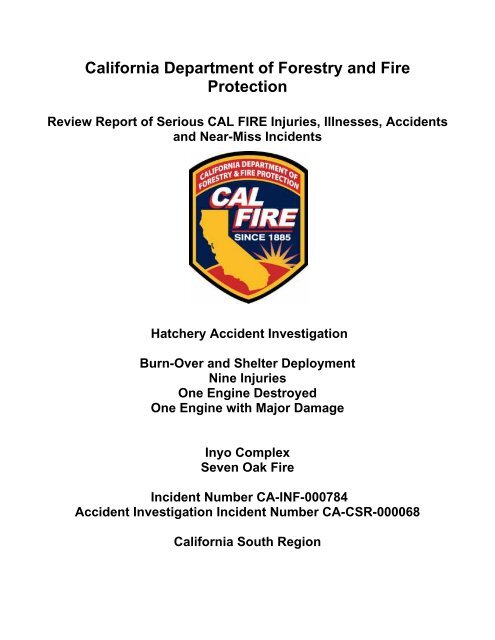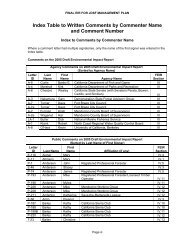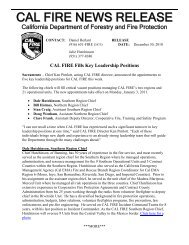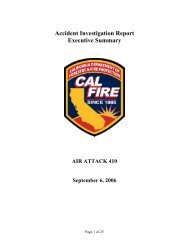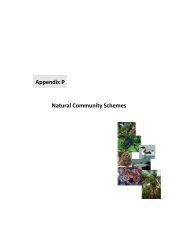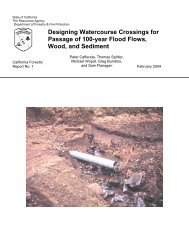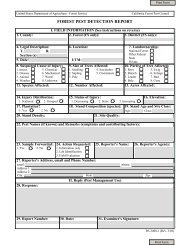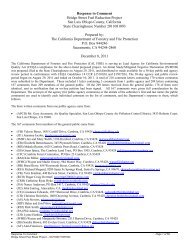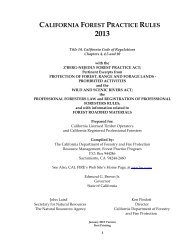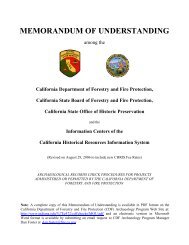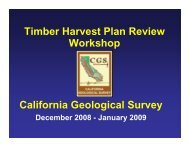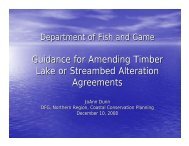Hatchery Accident Investigation - Cal Fire
Hatchery Accident Investigation - Cal Fire
Hatchery Accident Investigation - Cal Fire
Create successful ePaper yourself
Turn your PDF publications into a flip-book with our unique Google optimized e-Paper software.
<strong>Cal</strong>ifornia Department of Forestry and <strong>Fire</strong><br />
Protection<br />
Review Report of Serious CAL FIRE Injuries, Illnesses, <strong>Accident</strong>s<br />
and Near-Miss Incidents<br />
<strong>Hatchery</strong> <strong>Accident</strong> <strong>Investigation</strong><br />
Burn-Over and Shelter Deployment<br />
Nine Injuries<br />
One Engine Destroyed<br />
One Engine with Major Damage<br />
Inyo Complex<br />
Seven Oak <strong>Fire</strong><br />
Incident Number CA-INF-000784<br />
<strong>Accident</strong> <strong>Investigation</strong> Incident Number CA-CSR-000068<br />
<strong>Cal</strong>ifornia South Region
TABLE OF CONTENTS<br />
Page<br />
REVIEW TEAM PROCESS 3<br />
OVERVIEW OF ACCIDENT 6<br />
SEQUENCE OF EVENTS 8<br />
FINDINGS 24<br />
CAUSAL FACTORS ANALYSIS 27<br />
CONTRIBUTORY FACTORS 28<br />
CIRCUMSTANCES 30<br />
SITE CONDITIONS 35<br />
2
REVIEW TEAM PROCESS<br />
The review process of this incident comprised of an evaluation of the accident<br />
site along with analysis of the fuels involved and the burning conditions present<br />
at the time of the incident. Statements were taken from those involved to help<br />
construct a timeline and present a clear picture of the chain of events leading up<br />
to and through the conclusion of the incident.<br />
The Serious <strong>Accident</strong> Review Team (SART) was activated the evening of July 7,<br />
2007, with reporting instructions for the following morning. The team formed at<br />
the Independence <strong>Fire</strong> Station and received a briefing from San Bernardino Unit<br />
Chief and Division Chief #1. The team comprised of representatives from both<br />
CAL FIRE and the U.S. Forest Service (USFS). Team Members were Ed<br />
Wristen, Team Leader, Tulare Unit; Mike Davidson, Lead Investigator, Tulare<br />
Unit; Gad Amith and Mathew Brandt, Safety Program Representatives, Riverside<br />
Unit; Michelle Reugebrink, Safety Program Representative, Tahoe National<br />
Forest; Gabe Santos, Training Program Representative, Madera/Mariposa Unit;<br />
Hank Epling, CDF <strong>Fire</strong>fighters Representative, Lake Napa Unit; Darren Hensley,<br />
Automotive Technical Specialist, Riverside Unit; Pete Scully, <strong>Fire</strong> Behavior<br />
Technical Specialist, San Diego Unit; Tom Foley, <strong>Fire</strong> Shelter Technical<br />
Specialist, San Bernardino Unit; Eric Watkins, Investigator, Fresno Kings Unit;<br />
and Joe Aguirre and Doug Taylor, Technical Drawing Specialists, <strong>Cal</strong>ifornia<br />
South Region Office.<br />
The SART went to the secured accident site and conducted a thorough<br />
examination, identifying and marking the location of any fire suppression<br />
equipment that indicated pre-accident activities. The scene was documented<br />
with digital photographs, both from the ground and the air, and drawn as a plot<br />
plan. Please see those documents as an attachment to this report.<br />
3
Even though each member on the strike team was directed to provide a written<br />
statement, many of them were also interviewed by the team. The nine<br />
employees involved in the shelter deployment were all interviewed along with the<br />
strike team leader and other strike team personnel. The team also interviewed<br />
the command staff of the Seven Oak <strong>Fire</strong>, the medical personnel who rendered<br />
the initial medical care, and the tenant of the accident site. Transcripts or<br />
summaries of those interviews are included with this report.<br />
The safety program representatives examined, photographed, and cataloged all<br />
of the personal protection equipment (PPE) in use by those involved in the<br />
entrapment. They documented the injuries sustained and formulated a medical<br />
care timeline.<br />
The training program representative examined the training records of those<br />
involved. It was determined that everyone met or exceeded the minimum<br />
qualifications required for the positions held.<br />
The fire behavior technical specialist examined the physical characteristics of the<br />
accident site, gathered Remote Automated Weather Stations (RAWS) weather<br />
readings, analyzed fuel information, and utilized firsthand knowledge from those<br />
involved, to evaluate the fire’s behavior. That report is attached as supporting<br />
data.<br />
The automotive technical specialist examined the automotive equipment<br />
damaged in the burn-over along with their maintenance records. Arrangements<br />
were made to transport that equipment to the CAL FIRE automotive facilities in<br />
Davis. Because of scheduling conflicts with the tow company, the supervision of<br />
the equipment removal was turned over to the local unit.<br />
The fire shelter technical specialist, along with specialists from the USFS,<br />
examined and collected the fire shelters deployed during this entrapment. Each<br />
4
person involved in the deployment was interviewed as to the operation of the<br />
shelters.<br />
The technical drawing specialists divided the accident site into 50’ X 50’ grids.<br />
The location of each pertinent item was documented and incorporated into the<br />
final plot map drawing of the scene. Those drawings are included in this report.<br />
The investigation program representative collected two combination nozzles into<br />
evidence. A 1” nozzle was located at the end of the south most 1½” hose lay<br />
and a 1½” nozzle was located on the end of the north most 1½” hose lay. These<br />
items of evidence are stored in the Tulare Unit evidence locker.<br />
The accident site was secured 24 hours a day, until released by the SART.<br />
All team members, except the two safety program representatives, completed<br />
their assignments and returned to their home units, Thursday, July 12, 2007.<br />
The safety program representatives cleared the area the following day,<br />
July 13, 2007.<br />
5
OVERVIEW OF ACCIDENT<br />
On July 7, 2007, at approximately 1400 hours, burning activity on the “Seven<br />
Oak” fire intensified in Division “A”. The fire began traveling in a northeasterly<br />
direction towards the Mt. Whitney Fish <strong>Hatchery</strong>, a historic location. <strong>Fire</strong><br />
suppression personnel initiated a plan to burn out an area of vegetation between<br />
the hatchery and the main fire. At approximately 1415 hours the firing began<br />
under favorable wind conditions. A pie shaped section of land in front of the<br />
hatchery was successively burned out. The division supervisor decided to<br />
continue the burning to the west, where they could tie the line into an area that<br />
had burned the previous day. As the firefighters continued to “carry” the fire to<br />
the west, the wind conditions changed and the fire crossed North Oak Creek<br />
Road, the planned control line. The time was approximately 1430 hours.<br />
Strike Team 9442C was assigned to Division “A” and had engines positioned to<br />
pick up any spot fires which may occur from the burning operation. The strike<br />
team leader directed Engine 4480 to pick up the “slop over” and directed Engine<br />
4452 to assist. The fire was burning toward a riparian area containing structures.<br />
The engines entered the driveway located at 1659 W. Oak Creek Road and<br />
began two hose lays off of Engine 4480. Engine 4480 was staffed with a limited<br />
term fire apparatus engineer and four firefighters. Engine 4452 was staffed with<br />
a fire captain and three firefighters. The engineer off of Engine 4480 pointed out<br />
a small pond adjacent to the engine and identified it as their safety zone. The<br />
firefighters laid one hose lay toward the main fire and started a second hose lay<br />
toward a spot fire northwest of the engine’s location. The fire captain walked<br />
around the property assessing the area. Neither engine company had been<br />
down that driveway before and was surprised to see how many structures were<br />
located there. The firefighters felt they were making good progress with the<br />
hose lays and that they were going to be able to contain the fire. At<br />
approximately 1445 hours, the conditions quickly changed and the burning<br />
intensified. The winds increased and began changing directions. Realizing they<br />
6
were losing control, the firefighters dropped their nozzles and retreated toward<br />
the engine and the pond identified as their safety zone. Captain 4452 was<br />
separated from his crew and retreated to his engine and sought refuge in the<br />
cab. The engineer and seven firefighters entered the small pond and deployed<br />
fire shelters for extra protection as buildings and trees burned around them.<br />
A building behind Engine 4452 began to burn, so the captain moved the engine<br />
away from the heat. He would exit the engine periodically trying to cool down his<br />
surroundings.<br />
Air support arrived overhead and began dropping on the fire. Once conditions<br />
stabilized, the firefighters who sought refuge in the pond, left the pond and joined<br />
the captain at Engine 4452. Realizing it was still too hot, the entire group<br />
returned to the pond.<br />
The house adjacent to Engine 4452 continued to burn, eventually spreading to<br />
and igniting the engine. At approximately 1545 hours, the two engine crews<br />
were able to walk out of the accident site and join the rest of their strike team out<br />
on the road.<br />
This entrapment resulted in burn and respiratory injuries to all nine employees,<br />
the total loss to one Model 5 fire engine, and major fire damage to one Model 1<br />
fire engine. A Serious <strong>Accident</strong> Review was conducted to determine the chain<br />
of events which led to the entrapment so that the department may prevent this<br />
from occurring again.<br />
7
SEQUENCE OF EVENTS<br />
The Inyo Complex, 12 fires burning in the Owens Valley, was the result of a dry<br />
lightning storm that came through the valley on the early afternoon of July 6,<br />
2007. At approximately 2300 hours, a U.S. Forest Service (USFS) jurisdiction<br />
fire, the Seven <strong>Fire</strong>, and a state jurisdiction fire, the Oak <strong>Fire</strong>, burned together<br />
and became the Seven Oak <strong>Fire</strong>. The Seven Oak <strong>Fire</strong> was 8,000 acres in size<br />
and set up as a Unified Command fire with an Incident Commander from each<br />
agency. Even though the fire was<br />
in Unified Command, the CAL FIRE<br />
IC worked the north half of the fire,<br />
Division Y, and the USFS IC<br />
worked the south half of the fire,<br />
Division “A”. Each Division had its<br />
own tactical net. Division “A” was<br />
operating on Tac 2, Division Y<br />
The Oak <strong>Fire</strong>, Friday afternoon, east of the Mt. Whitney Fish <strong>Hatchery</strong><br />
was utilizing White 2. With multiple fires burning in the area, resources and relief<br />
were difficult to obtain.<br />
The Oak <strong>Fire</strong>, Friday night, east of the fish hatchery<br />
On July 6, 2007, at approximately<br />
2200 hours, Strike Team 9442C left<br />
Tuolumne/<strong>Cal</strong>averas Unit enroute to<br />
the Inyo Complex. The Strike Team<br />
consisted of engines E-4455, E-4461,<br />
E-4452, E-4480, and E-4466, led by<br />
B-4415. They arrived at Owens<br />
Valley Camp at approximately 0200<br />
hours and were assigned to the Seven Oak <strong>Fire</strong>. They were instructed to report<br />
to the Mt. Whitney Fish <strong>Hatchery</strong>, located northwest of the community of<br />
Independence, at 0800 hours; so, they slept for a couple of hours on the camp<br />
lawn.<br />
8
The Seven Oak <strong>Fire</strong> morning briefing was scheduled to be held at the<br />
Independence Airport at 0600 hours. The briefing was late and commenced at<br />
approximately 0700 hours. During the briefing, it was discovered that the<br />
Division “A” position had not been filled. A crew strike team leader from Los<br />
Angeles County <strong>Fire</strong> Department, was qualified to fill that position so he was<br />
appointed. The briefing was conducted by<br />
both Incident Commanders. Three strike<br />
teams of crews and Strike Team 9442C<br />
were assigned to Division “A”. The<br />
assignment for Division “A” was to keep<br />
the fire from running into the town of<br />
Independence and to protect the<br />
structures in the area of the Mt. Whitney<br />
The Mt. Whitney Fish <strong>Hatchery</strong><br />
Fish <strong>Hatchery</strong>. During the briefing, there was no mention of any structures being<br />
identified as non-defendable. Strike Team 9442C did not attend the morning<br />
briefing; their instructions were to report at the Mt. Whitney Fish <strong>Hatchery</strong> at 0800<br />
hours.<br />
At approximately 0755 hours, Division “A” set out to relieve the night shift crews.<br />
He assigned one crew to the fish hatchery to continue prepping the structures<br />
located there.<br />
Strike Team Leader 9442C received an in-the-field briefing by the incident<br />
commander at approximately 0800 hours. The IC informed Strike Team 9442C<br />
that he was assigned to Division “A” and that resources were limited. Strike<br />
Team 9442C was responsible for the areas of Fish <strong>Hatchery</strong> Road along with<br />
North, South, East, and West Oak Creek Roads. The protection of the historic<br />
Mt. Whitney Fish <strong>Hatchery</strong> was a high priority. The IC pointed out that there<br />
were homes located in the oak trees, but there was no discussion about the<br />
conditions of the homes or their defensibility. The area had been evacuated the<br />
9
day before and the evacuations were still in place even though the Sherriff’s<br />
Department was letting some people in to gather belongings. They discussed<br />
the erratic burning conditions from the day before and the predicted wind<br />
conditions for that day.<br />
<strong>Fire</strong> above the Bright Ranch approximately 0820 hours.<br />
Strike Team Leader 9442C conducted a<br />
thorough safety tailgate session with his<br />
crews before assigning them their tasks.<br />
They discussed the expected<br />
burning/weather conditions, radio<br />
frequencies, structure locations, use of<br />
PPE, and the importance of the hatchery.<br />
They programmed their portable radios to<br />
contain Inyo National Forest Net for Command, NIFC Tac 2 for tac, and Forest<br />
Service Air to Ground. Engine 4461 was assigned to relieve Engine 3561, at the<br />
Bright Ranch. The remaining engines were directed to familiarize themselves<br />
with the hatchery and the surrounding structures. Strike Team Leader 9442C<br />
familiarized himself with the fish hatchery and then began scouting out the<br />
structures located east of the hatchery. He was able to look at every structure in<br />
the area except for an old homestead just<br />
west of the fish hatchery. At<br />
approximately 0930 hours, his attention<br />
was drawn to an increase in fire activity up<br />
toward the end of South Oak Creek Road<br />
beyond the Bright Ranch. He drove up to<br />
investigate and discovered fire burning in<br />
an oak thicket. He directed Engine 4480<br />
to come in and address the threat.<br />
Entrance to the Bright Ranch.<br />
At approximately 1000 hours, Division “A” came into the area and did a face-toface<br />
with Strike Team Leader 9442C. By the conversation they had, Division “A”<br />
10
assumed the IC had already been there and had directed Strike Team 9442C to<br />
do structure protection. They looked at the current burning conditions and<br />
formulated a plan to possibly burn out the vegetation between the North and<br />
South Oak Creek Roads to reduce the threat to the fish hatchery if the fire<br />
continued to travel in that direction.<br />
Division “A” met with the Incident Commander at approximately 1200 hours and<br />
talked about getting additional resources. He had crews trying to cut line south<br />
of the Bright Ranch but the fire activity was picking up and they felt it was unsafe<br />
to continue without air support. Division “A” felt that the Sage <strong>Fire</strong> had a higher<br />
priority because resources continued traveling north. It was his understanding<br />
that he had to do the best he could with what he had.<br />
Helicopter 535 came into the area and agreed to support Engines 4480 and 4466<br />
and the hand crews as they cut line south of the Bright Ranch in an attempt to tie<br />
the fire line into a rock outcropping. Engine 4455 was assigned to patrol South<br />
Oak Creek Road, and Engine 4452 was directed to another area of the division<br />
called Onion Valley.<br />
<strong>Fire</strong> coming down toward the hatchery.<br />
At approximately 1400 hours, the fire<br />
crested a nearby knoll and continued its<br />
northerly travel toward the Mt. Whitney<br />
Fish <strong>Hatchery</strong> and other nearby<br />
residences. The afternoon winds were<br />
picking up and it was just a matter of<br />
time before the fire reached the area. A<br />
request for air support was made.<br />
Division “A” authorized Strike Team Leader 9442C to use fire on the South Oak<br />
Creek Road near the Bright Ranch to reduce the fuel along the road. Engine<br />
4452 was directed to return to the area of the fish hatchery.<br />
11
At approximately 1410 hours, Division “A” met both of the Incident Commanders<br />
and Strike Leader 9442C at the Mt. Whitney Fish <strong>Hatchery</strong>. Also present were<br />
IMT 3 Member A from Redlands <strong>Fire</strong> and his brother, IMT 3 Member B, from San<br />
Bernardino City <strong>Fire</strong>. They were on IMT 3 and were scouting the area for the<br />
transition. The group decided to start the planned backfire operation along North<br />
Oak Creek Road to reduce the fuel loading along the road. The CAL FIRE IC left<br />
the area to make contact with the Sheriff to ensure the area was evacuated. Los<br />
Angeles County hand crew 1173G, began burning out North Oak Creek Road.<br />
The burning started approximately a ¼ mile from the North & South Oak Creek<br />
intersection and they took fire to the southeast toward the intersection. The wind<br />
conditions were favorable, the fire was drawing in. They continued burning<br />
around the intersection and up South Oak Creek Road a short distance. E-4480<br />
and E-4466 were directed to support the burning operation. E-4455 and E-4452<br />
were directed to enter the hatchery and prepare for any possible extension.<br />
E-4461 was directed to stage at the intersection and watch for spots. The<br />
oncoming fire front was approximately 300 yards away and would be hitting the<br />
area of the hatchery.<br />
The CAL FIRE IC contacted an engine strike team assigned to Division Y and<br />
directed them to respond to the fish hatchery for structure protection. Chief #1<br />
responded with four of his engines. He deployed those engines and waited for<br />
further assignment. Chief #1’s strike team came into the Oak <strong>Fire</strong> the evening<br />
before, prior to the two fires merging, and staged at the Mt. Whitney Fish<br />
<strong>Hatchery</strong>. At that time, the fire was utilizing CAL FIRE Command 1 and White<br />
<strong>Fire</strong> 2 for tactical. Chief #1’s strike team was later reassigned to another area of<br />
the fire. Chief #1 was not aware that the fire was divided into divisions and that<br />
each division had its own command and tactical frequencies. Chief #1 was<br />
monitoring his assigned frequencies but did not hear any radio traffic. He was<br />
not aware that there was a burn-over occurring. When Chief #1’s engines<br />
arrived at the hatchery Friday evening, the local CAL FIRE engine gave them<br />
12
pre-plans of the hatchery and shared with them the fact that the residence just<br />
west of the hatchery was identified as undefendable. This information was not<br />
shared with any other equipment assigned to the fire.<br />
View of the Seven Oak <strong>Fire</strong> from the airport, 1150 hours<br />
View of the Seven Oak <strong>Fire</strong> from the airport, 1428 hours<br />
Division “A” directed Strike Team Leader 9442C to carry fire further up North Oak<br />
Creek Road toward the Oak Creek Campground. The campground had burned<br />
the day before so the intentions were to tie the burn into the black. The<br />
campground was identified as a safety zone for the resources working in front of<br />
the fire. Because the winds were still favorable, Strike Team Leader 9442C<br />
instructed 1173G to go in 50 feet and fire parallel to the road. His hopes were to<br />
add depth to the fire break and minimize the threat of the advancing fire front.<br />
The crew followed instructions and began burning out. This firing started just<br />
west of, and across the street from, 1659 West Oak Creek Road. Even though<br />
the address is listed as west, it is located on North Oak Creek Road. Almost<br />
immediately, at approximately 1430 hours, the winds changed to a southwest<br />
wind. Division “A” heard Strike Team Leader 9442C directing those firing, to<br />
narrow it up so that they were not taking such a big bite. Strike Team Leader<br />
9442C was concerned the firing was going to hit the road too hard. He<br />
positioned himself further to the west where he would have a better view. The<br />
fire did hit too hard and the fire crossed the road. A large dust/fire whirl formed<br />
and carried the fire into a riparian area just west of the hatchery which contained<br />
13
houses. The hand crew stopped the firing operation and proceeded up to the<br />
safety zone at the campground.<br />
The CAL FIRE IC returned and saw what was occurring. According to CAL FIRE<br />
IC, he told Division “A”, face to face, that there were structures in that area that<br />
were non-defendable. He told him that no engines are to go in there. He<br />
watched Division “A” talk on the radio as he walked away but could not<br />
remember what was said over the air or who it was said to. The USFS IC also<br />
heard the CAL FIRE IC tell Division “A” not to protect that structure. Division “A”<br />
did not remember anyone telling him the structures were undefendable, he did<br />
not share that information with Strike Team Leader 9442C. IMT 3 Member B,<br />
who was riding in the back of Strike Team Leader 9442C’s vehicle, heard Strike<br />
Team Leader 9442C direct his engines to “get into the structure and protect the<br />
home.”<br />
Strike Team Leader 9442C stated that he directed E-4480 to try to catch the<br />
slop-over. He directed E-4452 to come in and give E-4480 a hand. He said that<br />
he did not direct them into the driveway, his intentions were not structure<br />
protection but to pick up the fire.<br />
E-4480 had three firefighters spread out along North Oak Creek Road looking for<br />
spot fires with back pumps. The fourth firefighter was in the cab with the<br />
engineer. When Engineer 4480 received his directions, he notified the other<br />
firefighters and started backing down the driveway of 1659 West Oak Creek<br />
Road, a driveway they had not been in before. Engineer 4480 spotted the<br />
engine in a small open area between two wooden bridges. He exited the engine,<br />
looked around, and pointed out a small pond located next to the engine and<br />
identified it as their safety zone. Engineer 4480 later stated that he was<br />
uncomfortable with the assignment and chose not to go in any further than he<br />
did. He felt it was too dangerous. Several spot fires were visible so the crew<br />
began extending two 1 ½” hose lays.<br />
14
E-4452 was staged on North Creek Road, west of the Y intersection, while the<br />
burning operation was being conducted. Captain #1 heard the Strike Team<br />
Leader direct E-4480 to drive in there and check the area because spots were<br />
starting to land on that side of the road. E-4480 reported back that there were<br />
spots all over and they needed some help. Strike Team Leader 9442C instructed<br />
E-4452 to go in and give them a hand.<br />
The firefighters from E-4480 began laying hose when a private vehicle loaded<br />
with personal property came out from around a structure. The driver, a 77-yearold<br />
female, lived on the property. At about this same time, E-4452 was entering<br />
the property to assist. Both engines had to move out of the way to allow the<br />
civilian to escape. Engineer 4480 stated that if it were not for him moving his<br />
engine to let the civilian out, Engine 4452 would not have gotten around him and<br />
entered further onto the property.<br />
The engines continued to set up their suppression activities, with the crew<br />
members from E-4452 assisting with the hose lays off of E-4480. One hose was<br />
laid to the west toward the outer boundaries of the riparian. The other was<br />
stretched to the northwest behind the structures where spots were visible.<br />
Captain 4452 maneuvered his engine around Engine 4480 and crossed a second<br />
wooden bridge where he backed up into an opening north of the pond. Captain<br />
4452 walked the perimeter of the area, sizing up the situation. At first, things<br />
were looking pretty good and everyone felt they were going to be able to pick the<br />
fire up. Then, the main fire hit and the intensity suddenly increased. The fire got<br />
up into the trees, making the hose streams ineffective. The firefighters off<br />
E-4480 recognized that they were in trouble and began heading to the pond<br />
identified earlier as their safety zone. The crew from E-4452 saw what was<br />
happening and followed suit. Captain 4452 was separated from his crew and<br />
sought refuge in the cab of the engine as the fire compromised their position.<br />
Engineer 4480 entered the pond and notified Strike Team Leader 9442C that<br />
15
they were being overrun with fire. This information was relayed to Division “A”<br />
and air support was requested. <strong>Fire</strong> shelters were deployed in the pond for extra<br />
protection. A couple of the firefighters could not get their shelters opened. So<br />
they shared with others. <strong>Fire</strong>fighters were holding their breath underwater as<br />
long as they could to escape the intense heat.<br />
The Inyo National Forrest dispatch log shows that at 1454 hours, the USFS IC<br />
requested the Independence ambulance to standby at the Mt. Whitney Fish<br />
<strong>Hatchery</strong>. This request was placed prior to the burn-over incident. There was no<br />
indication that this volunteer ambulance was staffed and responded.<br />
The Inyo National Forrest dispatch log shows that at 1505 hours, the USFS IC<br />
requested an immediate need for air tankers to support trapped firefighters.<br />
In the pond, roll call was taken and the crews continued to communicate with<br />
each other and Strike Team Leader 9442C. Structures, vehicles, and trees were<br />
burning all around them as they attempted to stay calm. Captain 4452 moved his<br />
engine around trying to keep it away from the heat. He would exit the vehicle<br />
periodically and spray water with his hardline, trying to keep things cool. He<br />
removed his fire shelter from its case and<br />
unfolded it in the cab in case it got to where he<br />
felt he needed it.<br />
Air Tactical Bravo 5 had just arrived on the<br />
Inyo Complex and was in a holding pattern<br />
over the Seven Oak <strong>Fire</strong> when he noticed fire<br />
running toward some structures. Bravo 5<br />
came up on the air to ground frequency and<br />
Air Tanker coming in to assist.<br />
heard the USFS IC calling for Air Attack 410. Bravo 5 offered his assistance and<br />
learned that there were firefighters trapped and that they needed immediate air<br />
support. Bravo 5 called in two S2 Tankers that he had in orbit just south of the<br />
16
fire, and directed them to drop on the houses.<br />
brought in to assist; they were Copters 534, 554, and 551.<br />
Three helicopters were also<br />
Division “A” made a note on his steno pad documenting the time of the burn-over<br />
as 1445 hours. He also documented tanker drops at 1450, 1455, and 1505<br />
hours.<br />
After awhile, things calmed down on the ground and the crew members exited<br />
the water and moved toward E-4452. They gathered in a group at E-4452, using<br />
their shelters around them as a shield. Those who had lost their shelters in the<br />
water were placed in the middle, protected by the group. The house adjacent to<br />
the engine was on fire and fire was burning the trees to the north.<br />
<strong>Fire</strong> Fighter photo of Air Tanker drop<br />
While the burn-over was occurring, Strike<br />
Team Leader 9442C handed his camera<br />
to a fire fighter from Engine 4466 and<br />
directed him to take pictures. The Strike<br />
Team Leader also took time to call his<br />
unit chief and advised him that he was<br />
burning up two of his engines. He<br />
wanted to advise the chief before he read<br />
it in a flash report. When the fire intensity seemed to decrease, Strike Team<br />
Leader 9442C attempted to drive into the<br />
premises. He was able to get within 50 feet<br />
of the cattle guard, but the heat did not<br />
allow him to get any closer. He returned to<br />
his vantage point up on North Oak Creek<br />
Road where he continued to check in with<br />
those involved via the radio.<br />
<strong>Fire</strong>fighter photo during entrapment.<br />
17
The structure next to Engine 4452 became more involved. The group, huddled<br />
near the engine, decided to return to the safety of the pond, and Captain 4452<br />
joined them. They watched as the burning structure heated an adjacent propane<br />
tank to venting temperatures. The propane fire spread to Engine 4452, totally<br />
consuming it. Eventually, conditions cooled to the point where the crew felt they<br />
could walk out to the road. Engineer 4480 got out and checked and gave the OK<br />
for the rest of the crew. Four of the crew members carried their shelters with<br />
them to the cattle guard before disposing of them.<br />
At 1551 hours, it was announced that those involved in the entrapment were out<br />
and OK.<br />
At 1559 the USFS IC announced that there were no injuries and ordered a<br />
Critical Incident Stress Debriefing for the following day.<br />
Strike Team Leader 9442C was in the driveway when the firefighters came<br />
walking out. They all gathered to greet<br />
and hug each other. Strike Team Leader<br />
9442C stated that they were all standing,<br />
they were all talking, and they all looked<br />
pretty good for what they had been<br />
through. Division “A” told him that he had<br />
ordered a medic unit and that it was on its<br />
Gathering after entrapment.<br />
way. Everyone was milling around,<br />
getting something to drink, removing PPE,<br />
and taking photographs. Division “A” was prodding the group trying to get them<br />
moving to the airport where an ambulance was supposed to meet them. After<br />
determining that there were no apparent injuries, Strike Team Leader 9442C,<br />
Captain 4452, and Engineer 4480 and several fire fighter re-entered the site to<br />
see what damage occurred to the engines and retrieved what personal<br />
belongings they could. They all looked around, discussing the incident and<br />
18
taking pictures. E-4480 was still running so<br />
Strike Team Leader 9442C directed<br />
Engineer 4480 to drive it out to the road.<br />
Group re-enters burn-over site and takes pictures.<br />
Strike Team Leader 9442C admitted that<br />
Division “A” told him three or four times that<br />
he needed to get everyone moving. The<br />
crew members were eventually loaded<br />
onto the remaining engines and transported to the Independence Airport for a<br />
medical evaluation. Engineer 4480 drove his engine to the airport. They arrived<br />
at the airport at 1715 hours but there were no ambulances present. At 1720<br />
hours, the USFS IC notified his dispatch center that the Strike Team Leader was<br />
requesting a medical flight for one person with 3 rd degree burns on an ear. At<br />
1725 hours, two more injured employees were added to that request. The<br />
injuries to one were burns to the face, ear, and back; and other with burns to the<br />
face, eyebrows, and possibly eyes.<br />
At 1758 hours, plans were in place to transport the firefighter with burns on his<br />
face, ear, and back to Lone Pine by ambulance and flown out from there. The<br />
other two fire fighters were to be transported to Northern Inyo Hospital and flown<br />
from there. Strike Team Leader 9442C told the USFS IC that it was CAL FIRE<br />
Burn Policy, to transport burn injuries directly to the burn center. He would not<br />
allow his crew members to go to the local<br />
hospital. The transportation plans in<br />
place were put on hold and other<br />
arrangements were started.<br />
After waiting for the ambulance to arrive,<br />
Division “A” drove into town and located<br />
one. At approximately 1825 hours, he<br />
Engine 4452 burning.<br />
directed the ambulance to the airport, where Lone Pine paramedics began<br />
19
evaluating those involved in the burn-over. A second ambulance arrived at the<br />
airport and assisted with the evaluations. It was determined that two firefighters<br />
and Engineer 4480 needed to be transported to the burn center in Fresno. The<br />
remaining employees were evaluated but refused oxygen therapy with many<br />
denying injuries or complaints.<br />
Division Chief #1 arrived at the airport as the last two firefighters were being<br />
evaluated. The paramedic approached him and informed him that they wanted<br />
to transport three fire fighters to Northern Inyo Hospital for further evaluation. He<br />
told them that as per CAL FIRE policy, they needed to be transported to the<br />
nearest burn center. Division Chief #1 called Unit Chief #1 who concurred that<br />
they needed to be transported to the burn center.<br />
Division Chief #1 met with those involved in the burn-over and instructed each of<br />
them to write down what occurred to provide to the SART. He contacted the Red<br />
Cross for assistance but got an answering machine. Red Cross never returned<br />
his call. Division Chief #1 directed Strike Team Leader 9442C to stop at the<br />
Bishop K-Mart and purchase clothing for his crew. Strike Team Leader 9442C<br />
told him that between the strike team they would have enough clothing for the<br />
crew. Strike Team Leader 9442C also told him that he could CAL-Card their<br />
meals.<br />
Because of weight and altitude issues getting over the Sierras, the local medical<br />
helicopter could only take one patient at a time. This would require three<br />
separate trips back and forth to transport the injured, which would take an<br />
extended period of time. A fixed wing aircraft was ordered that was capable of<br />
transporting all three injured firefighters to the Fresno Burn Center. The aircraft<br />
experienced some mechanical problems and CHP assisted by providing a code<br />
three transport for the mechanic. At 1839 hours, it was determined the plane<br />
was inoperable, which forced another change in the transportation plans. Two<br />
helicopters were coming from Fresno with 50-60 minute ETAs.<br />
20
It was decided to take those injured to Lone Pine by ground ambulance to await<br />
the helicopters. At 1940 hours, two of the crew members were picked up by<br />
Mercy Air. At 1955 hours, the last crewmember was picked up by the CHP<br />
helicopter and transported to the Fresno Burn Center.<br />
The remainder of the strike team drove themselves to a motel in Mammoth<br />
Lakes, two hours away. Attempts were made to locate rooms in Bishop, but with<br />
the fires and the road closures, there were no rooms available. The strike team<br />
arrived at Mammoth Lakes in time to catch the last restaurant open before<br />
closing for the night. The next day, Strike Team Leader 9442C gave those who<br />
lost their belongings $60 out of his own wallet to go replace the basics, such as<br />
toothbrushes and razors, that were lost in the fire. Strike Team Leader 9942C<br />
was the only CAL Card holder on the strike team. Based on the magnitude of the<br />
personnel issues facing this Strike Team, he felt hard pressed to ensure his<br />
personnel were OK and coping with what had happened to them, as well as<br />
provide for their personal needs.<br />
Captain #2, Tuolumne/<strong>Cal</strong>averas Unit, came over and conducted a critical<br />
incident stress debriefing Sunday morning. Monday morning, approximately<br />
0900 hours, he contacted Division Chief #1 and informed him that two of the<br />
firefighters were experiencing respiratory problems and asked if it was OK to take<br />
them to the local hospital.<br />
At approximately 1030 hours, Division Chief #1 received a telephone call from<br />
Unit Chief #2. Unit Chief #2 expressed his concerns that the local hospital was<br />
only giving the firefighters inhalers. It was also discovered by the SART that<br />
another firefighter had burn injuries. It was decided to transport the remaining six<br />
employees involved in the burn-over to the Fresno Burn Center for further<br />
evaluation. The Team Medical Unit Leader was contacted and arrangements<br />
were made to fly the fire fighters from Mammoth to Fresno.<br />
21
Captain #2 expressed his concerns that the strike team felt as if they had been<br />
abandoned. Nobody from the forest ever came to check on their welfare or see if<br />
they needed any further assistance. They felt the CAL FIRE supervisors only<br />
came after complaints were voiced and only made brief appearances.<br />
July 9, 2007, at 1817 hours, Investigators interviewed the tenant of 1659 W. Oak<br />
Creek Road. She stated that she was evacuated from her home on Friday, July<br />
6, 2007. The tenant returned to the area Saturday, at approximately 1100 hours,<br />
and found no one posted at the road closed sign. She drove home feeling safe<br />
with all of the aircraft working. Even though she did not think there was any<br />
danger, she continued to put personal items into her car. She stated that she<br />
was inside the house when she sensed a change in conditions. She got into her<br />
car to leave and saw the firefighters on her property. The firefighters had to<br />
move their trucks so that she could leave. As she left, she observed what she<br />
called the bunkhouse begin to burn.<br />
July 10, 2007, the remainder of the Strike Team was released to return to their<br />
home unit.<br />
Friday, July 13, 2007, at 1800 hours, the Seven Oak <strong>Fire</strong> was contained at<br />
28,708 acres. The containment lines were 80percent man-made, with 20 percent<br />
being natural barriers.<br />
22
FINDINGS<br />
All personnel were properly trained and qualified for the positions they held. As a<br />
result of a fire fighter fatality in 2004, Tuolumne/<strong>Cal</strong>averas Unit trains all of its<br />
personnel the S-190 class. (Training Program Report, Statement of B-4415)<br />
A good safety tailgate session was conducted by ST 9442C at the beginning of<br />
the shift. (Statements from members of ST9442C)<br />
The Limit Term FAE identified the pond to his crew as a safety zone.<br />
(Statements from Engineer 4480 and his crewmembers)<br />
At the time of the burn-over, proper personal protective equipment was in use<br />
and performed as expected. (Statements from involved employees and the<br />
Safety Program Report)<br />
Good communications occurred during the burn-over. (Statements from involved<br />
employees, B-4415, and Division “A”)<br />
A 1” nozzle was being utilized on one of E-4480s 1½” hose lays. (Evidence<br />
collected at scene)<br />
Five old style fire shelters and two new generation shelters were deployed in a<br />
small pond. (Statements from involved employees, <strong>Fire</strong> Shelter Program Report)<br />
Two fire fighters experienced difficulties removing their fire shelters from the PVC<br />
bag. (Statements from involved employees, <strong>Fire</strong> Shelter Program Report)<br />
1659 W. Oak Creek Road has a history of being in violation of the PRC 4291.<br />
(Statements from CAL FIRE IC)<br />
23
Local firefighters are familiar with 1659 W. Oak Creek Road and knew that it had<br />
been identified as un-defendable in a wildland fire situation. (Statements from<br />
CAL FIRE IC)<br />
The undefendable status of 1659 W. Oak Creek Road was not shared with ST<br />
9442C prior to the burning operation. (Statements from CAL FIRE IC, Division<br />
“A”, B-4415)<br />
ST 9442C, E-4480, or E-4452 did not have the opportunity to recon 1659 W. Oak<br />
Creek Road prior to the threat. (Statements from B-4415, Captain #1, and<br />
Engineer 4480)<br />
Division “A” did recon 1659 W. Oak Creek Road prior to the threat and felt that it<br />
may be defendable depending on burning conditions at the time. (Statement of<br />
Division “A”)<br />
Engineer 4480 felt uncomfortable at 1659 W. Oak Creek Road, yet chose to stay<br />
and initiate suppression actions. (Statement of Engineer 4480)<br />
<strong>Fire</strong>fighters felt that they were picking the fire up, but the conditions changed and<br />
the fire increased in intensity. (Statements from involved employees)<br />
Southern <strong>Cal</strong>ifornia is experiencing a drought; fuel conditions are extreme. (<strong>Fire</strong><br />
Behavior Analysis Report)<br />
Weather conditions on the Seven Oak <strong>Fire</strong> were predicted and expected.<br />
(Statements from CAL FIRE IC, Division “A”, and B-4415)<br />
The rapidly progressing fire compromised fire fighter safety which forced fire<br />
fighters to take refuge in the pond. (Statements from involved employees)<br />
24
The main fire would have crossed N. Oak Creek Road and hit 1659 with more<br />
intensity than the slop-over fire did. (Statements from CAL FIRE IC, Division “A”,<br />
B-4415, and the <strong>Fire</strong> Behavior Analysis Report)<br />
Other fire activity in the area impacted the availability of resources. (Statements<br />
from CAL FIRE IC, Division “A”, and B-4415)<br />
Initial Attack resources worked in excess of 24 hours. Even though resources<br />
were tired, fatigue did not appear to affect the decision-making process.<br />
(Statement of CAL FIRE IC)<br />
The accident occurred during the transition period to an Incident Command<br />
Team. (Statements from CAL FIRE IC, Division “A”, IMT 3 Members A & B)<br />
Radio frequency assignments were in place, but not all resources were<br />
monitoring proper channels. (Statements from CAL FIRE IC, USFS IC, Division<br />
“A”, B-4415, Chief #1)<br />
There was no written IAP and Strike Team 9442C did not attend the morning<br />
briefing. (Statements from CAL FIRE IC, Division “A” and B-4415)<br />
Providing medical treatment, and air transportation for the injured, to the Burn<br />
Center, was much delayed. (Statements from CAL FIRE IC, Division “A”,<br />
B-4415, crewmembers involved, Ambulance Personnel, Safety Program Report)<br />
25
CAUSAL FACTORS<br />
Engineer 4480 entered 1659 W. Oak Creek Road and observed the condition of<br />
the property. Even though he did not feel comfortable with the assignment, he<br />
gave direction to his crewmembers to begin laying hose.<br />
Engineer 4480 stated that he did not feel comfortable with the assignment<br />
once he saw what it involved. Yet he initiated a plan which involved two<br />
hose lays off his engine instead of exiting.<br />
Captain 4452 entered 1659 W. Oak Creek Road and observed the condition of<br />
the property. He supported the plan initiated by Engineer 4480 by directing his<br />
crewmembers to assist the crew of E-4480 with their hose lay.<br />
Captain 4452 had an opportunity to re-evaluate their situation when he<br />
had to back out of the way to let the civilian escape. He chose to stay and<br />
even caused damage to his engine trying to get further into the property.<br />
26
CONTRIBUTORY FACTORS<br />
The undefendable status of 1659 W. Oak Creek Road was never communicated<br />
to Strike Team 9442C.<br />
Per statements taken, CAL FIRE IC and the local Engine Companies were<br />
aware of the conditions at 1659 W. Oak Creek Road. The property has a<br />
history of being in violation of PRC 4291. This information was not shared<br />
with anyone during the morning briefing or fire line meetings.<br />
Members of Strike Team 9442C scouted out the properties east of Mt. Whitney<br />
Fish <strong>Hatchery</strong> but did not make it to 1659 W. Oak Creek Road, which is just west<br />
of the hatchery.<br />
Per statements taken, B-4415, E-4452, and E-4480 each scouted out the<br />
properties east of the hatchery. Neither made it to 1659 W. Oak Creek<br />
Road prior to the burn-over.<br />
Shift in wind conditions caused the firing out operation to jump the road and run<br />
into the riparian area.<br />
Per statements taken, CAL FIRE IC, USFS IC, Division “A”, and B-4415.<br />
This accident occurred during the transitional period to an Incident Command<br />
Team.<br />
Per statements taken, the Initial Attack ICs worked the incident in excess<br />
of 24 hours without sleep. The Incident Command Team was on scene at<br />
approximately 1000 hours yet the transition was set for 1800 hours. The<br />
fire continued to operate as a reactionary initial attack fire with limited<br />
resources and without any maps or IAP.<br />
27
The tenant violated the evacuation order and re-entered the premises. The<br />
engines had to move to give the tenant the opportunity to escape. The moving of<br />
E-4480 allowed E-4452 the opportunity to commit himself further onto the<br />
property.<br />
Per statements taken, E-4480’s initial position blocked the driveway<br />
preventing E-4452 from getting past. Once that engine was moved,<br />
E-4452 proceeded around E-4480.<br />
<strong>Fire</strong> suppression personnel resorted to their core training, which saved their lives.<br />
Per statements taken, the pond had been identified as a safety zone, if<br />
needed, by Engineer 4480. When things did not work as planned, each<br />
employee resorted to their core training and gathered at their identified<br />
safety zone. They communicated with, and supported one other. Working<br />
as a team, they survived this incident.<br />
28
CIRCUMSTANCES<br />
Weather conditions on Friday, the day the fires started, were frequent lighting<br />
strikes along the high country accompanied by strong, gusty and erratic winds.<br />
Temperatures were in the high 90’s to low 100’s with a reading of 103 recorded<br />
at the Oak Creek RAWS (located 1.1 miles NW of accident site) at 1647 hours.<br />
On scene fire personnel recorded at least one wind gust to 58 mph on a hand<br />
held Kestrel weather meter. Relative humidity was generally in the single digit<br />
readings. One hour fuel moistures were reported by fire personnel to be 0-2<br />
percent.<br />
Weather conditions on Saturday, the day of the accident, skies were clear with<br />
no cumulous build-up. Day time temperatures ranged from the low 90s to 100<br />
degrees at 1247 hours. Day time relative humidity’s ranged from a high of<br />
13percent to a low of 4percent at 1447 hours. Also at 1447 a wind gust was<br />
recorded at the Oak Creek RAWS of 50 mph. Winds in the afternoon were<br />
sustained 10 to 15 mph gusting into the 30’s. One hour fuels would have been<br />
similar to Friday’s readings of 0-2percent.<br />
Weather conditions recorded at the Oak Creek RAWS at the time of the accident<br />
were Temperature 97 degrees, RH 5percent, winds 13 with gusts to 32 mph.<br />
Winds at the accident site at the time of the incident were reported to be 20-30<br />
mph out of the SW.<br />
Normal rainfall in the Owens Valley area as recorded at Bishop by the NWS<br />
shows a 30-year average of 5.02 inches for the period of July through June.<br />
Rainfall recorded for the period of July 06 through June 07 was only 1.52 inches.<br />
This is a deficit of 3.50 inches and is only 30percent of normal.<br />
This severe rainfall deficit combined with the nature of the area has resulted in<br />
extremely low Live Fuel moisture in the native vegetation. Conditions for this<br />
29
area are classified as in “Extreme Drought” on the Palmer Drought Index<br />
produced by NOAA.<br />
Burning Index (BI) is another indicator of fire line intensity and is also calculated<br />
by the Inyo National Forest. BI can be used to give a rough estimate of average<br />
potential flame length. The BI for July 6 and 7 were 110 and 127 respectively.<br />
This equates to an average flame length of 11 and 13 feet respectively. This is<br />
an average only and wind gust or other modifying conditions can substantially<br />
increase or decrease these values.<br />
In summary, the conditions present in the days before and the day of the<br />
accident, extremely dry fuels, high temperatures, low relative humidities and<br />
strong gusty and erratic winds, all indicate the potential for extreme fire behavior<br />
with rapid spread rates, long flame lengths, spotting potential and blow-up<br />
conditions.<br />
The local Inyo National Forest has opted to utilize energy release component<br />
(ERC) as the basis for their Pocket Briefing Cards fire danger relationship with<br />
past conditions. ERC is a measure of fire line intensity. ERCs for Friday, July 6<br />
and Saturday, July 7, as calculated by the Inyo Forest for Oak Creek were 25<br />
and 26 respectively. These numbers are above the 97 percentile mark and<br />
appear to be the highest ever recorded. Whether or not a record, these numbers<br />
indicate extreme fire potential. A reading above the 97percent mark indicates<br />
that the ERC is higher than would be found 97percent of the time over the 20<br />
years of records covered on the card.<br />
<strong>Fire</strong> behavior on Friday was reported to be extreme with flame lengths of 15’ to<br />
40’ depending on wind conditions. Rates of spread ranged form moderate as the<br />
winds eased to extreme when running with the wind. Personnel reported several<br />
instances of “sheeting”, a term used to describe a fire that moves so fast entire<br />
30
areas are consumed in seconds. Spotting was also reported to be occurring ¼ to<br />
¾ of a mile ahead of the fire fronts.<br />
<strong>Fire</strong> behavior as reported by fire personnel on Saturday was significant<br />
throughout the day as the main fire moved off the high country to the North East.<br />
Crews conducted firing operations in an effort to create black line along North<br />
and South Oak Creek Roads. Winds at the time were light and crews had<br />
difficulty obtaining sufficient depth on the black line. By early afternoon crews<br />
has successfully completed firing form the intersection of North and South Oak<br />
Creek Roads approximately ¼ mile to the west and southwest. Observed flame<br />
lengths on this burning operation were from 5’ to 15’. Winds were light and<br />
somewhat variable.<br />
After completion of the first firing operation, the decision was made to make use<br />
of favorable winds to continue firing West on North Oak Creek road in advance of<br />
the main fire. Main fire was approximately ¾ mile Southwest and moving<br />
Northeast. As firing commenced at approximately 1500 hours, a pronounced<br />
change in wind conditions occurred. Winds went from nearly calm to strong<br />
Southwest. This resulted in the lit fire running hard to North Oak Creek road and<br />
crossing to the North side. This “slop-over” then progressed toward what would<br />
become the accident site. At the time of the slop-over the main fire was reported<br />
to be approximately 75 yards to the Southwest; had the firing operation not been<br />
attempted and the slop-over not occurred, the main fire would have crossed the<br />
road and produced a similar or worse result.<br />
The following sequences of events are based on burn patterns, leaf freeze,<br />
photos and witness statements.<br />
The slop-over moved with a rapid rate of spread through the shrub fuels and into<br />
the riparian area with flame lengths estimated to be in excess of 50’, pushed by<br />
strong, gusty Southwest winds. These winds were the result of the onset of the<br />
31
normal down slope, down canyon winds. After the initial run into the riparian to<br />
where engine 4480 was engaged, subsequent runs engulfed the driveway<br />
access and cutting of the engines egress.<br />
A short time later the fire pushed due north running through the Western edge of<br />
the riparian to the Northern edge. Flame lengths on this run, as evidenced by<br />
photos were near 100’. As a result of both of these runs through the broad leaf<br />
vegetation, numerous fire brands were cast into the riparian area igniting spot<br />
fires through out in the receptive duff material.<br />
As the fire arrived on the Northern edge of the riparian area it became influenced<br />
by conflicting winds blowing down the West-East aligned North fork of Oak Creek<br />
and other minor drainages. The result was a 180 degree shift in wind causing<br />
the fire to run back through the riparian to the South. This third run was far more<br />
intense, with flame lengths well in excess of 100’, due to significant pre-heating<br />
from the previous run. Smaller finger runs progressed to the southeast deeper<br />
into the riparian area. By this time the fire was well established in the riparian<br />
with significant heat generation. This extreme convected heat, coupled the<br />
competing drainage winds caused the fire to move in multiple directions, all the<br />
while building additional heat load.<br />
The final run affecting the accident site began on the Northwest corner of the<br />
riparian and moved East along the riparian perimeter. Based on the deep char<br />
and significant fuel consumption of the mature trees and heavy spalling on the<br />
rocks adjacent to the riparian, I believe this final run was in the form of a intense<br />
fire whirl.<br />
Conditions in the riparian area where the engines were located quickly became<br />
unmanageable due to extreme heat, multiple fire fronts impacting the area and<br />
spotting throughout. Adding to the heat load were several structures and large<br />
volumes of stored man-made materials including flammable gasses and liquids.<br />
32
Personnel in the area had to seek shelter in the pond due to the extreme heat<br />
and choking smoke produced by the burning materials. Temperatures remained<br />
extreme for several hours due to deep seated heat and continuing burn out of<br />
heavy materials.<br />
At some point after the accident, the fire moved out of the riparian to the North<br />
burning approximately ¾ of a mile through the shrub fuel before halting at its final<br />
perimeter.<br />
Those involved in the burn-over, had put in a full day of work before being<br />
dispatched to the Inyo Complex. They left their home Unit at approximately 2200<br />
hours and arrived in Owens Valley at approximately 0200 hours. Because there<br />
were no motel vacancies available, they chose to sleep on the lawn at Owens<br />
Valley Camp. The Strike Team was awoken at 0500 hours when the lawn<br />
sprinklers came on. The Strike Team ate breakfast arrived at the Mt Whitney<br />
Fish <strong>Hatchery</strong> at 0800 as instructed. Even though the Strike Team was<br />
operating on a minimum amount of the sleep, they did not feel that fatigue played<br />
a role in the accident.<br />
The training records of those involved were examined. It was determined that<br />
everyone met or exceeded the minimum qualifications required for the positions<br />
held.<br />
The Personal Protection Equipment in use by those involved in the entrapment<br />
were examined, photographed, and cataloged. Through interviews and<br />
equipment examination, it was determined that everyone was wearing full<br />
protective equipment and that the equipment operated as it was designed to.<br />
33
SITE CONDITIONS<br />
<strong>Accident</strong> site is located on an alluvial plain approximately 4000 feet east from the<br />
base of the escarpment that begins the eastern slope of the Sierra Mountain<br />
range. Slope from the base of the escarpment east to the valley floor, a distance<br />
of approximately 5 miles, averages 7percent. Slopes on the escarpment range<br />
from 30-50percent on the lower areas to near vertical at the higher elevations.<br />
Slope at the accident site is 7percent.<br />
The eastern slope of the Sierra is marked by a series of steep drainages aligned<br />
from west to east. These drainages help to amplify and funnel the diurnal wind<br />
that occur each afternoon as the valley heats and rising air is replaced by cooler<br />
air from the west.<br />
The accident site is located at the confluence of the South and North forks of Oak<br />
Creek. These creeks and associated drainages, though not deep or pronounced<br />
appear to have had a directional effect on the fires spread. Additionally, both of<br />
these creeks have abundant flowing water which allows the riparian area<br />
involved to exist and sustain the heavy vegetation present prior to the accident.<br />
Though slope was not a direct factor in the accident, the proximity of the site to<br />
the steep escarpment, placed it well within the influence of the strong down slope<br />
winds that historically occur in this area every afternoon in the summer months.<br />
Fuels on the alluvial planes (outside the accident site) are made up of several<br />
shrub species with very sparse grass. Species present include Black Brush,<br />
Rabbit Brush, Great Basin Sage, <strong>Cal</strong>ifornia Buckwheat, Mormon Tea, Burro<br />
Brush and other local shrubs. According to local fuels management personnel,<br />
this fuel type is not represented by any of the Behave fuel models. Fuels are<br />
generally sparse and require wind for fire spread.<br />
34
No records of live fuel moistures could be obtained and local personnel did not<br />
know of any LFM ever being sampled in this area. Fuels are obviously extremely<br />
dry and flammable due to the present drought conditions. Fuel conditions were<br />
described by some local fuel managers as “explosive”.<br />
Fuels in the riparian area where the accident occurred were very different<br />
containing several species of mature trees. Cottonwood, Poplar, Live Oak,<br />
Willow, Pine and Cypress are the most prominent. Trees ranged in height from<br />
10’ to near 100’. Canopy was near 100percent crown closure. Also present<br />
were unidentifiable (due to burned nature) brush and large shrub species. A<br />
heavy duff layer was also present.<br />
Littered throughout the accident area was a heavy concentration of small<br />
structures and stored man made materials of various make-up, many appeared<br />
to be highly flammable. The location has a history of being in violation of Public<br />
Resource Code section 4291.<br />
Local fire personnel reported that fires occurring in these types of riparian areas<br />
historically burn readily with great intensity, long flame lengths and extreme heat.<br />
35


